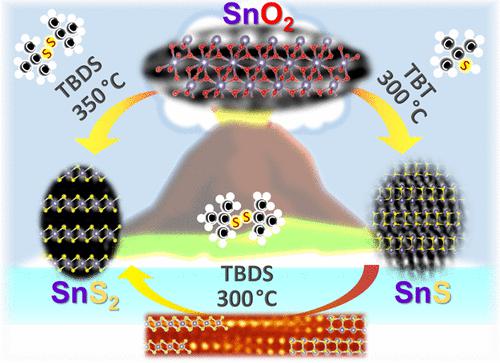当前位置:
X-MOL 学术
›
Chem. Mater.
›
论文详情
Our official English website, www.x-mol.net, welcomes your feedback! (Note: you will need to create a separate account there.)
Synthesis of In-Plane Oriented Tin Sulfides by Organosulfur-Mediated Sulfurization of Ultrathin SnO2 Films
Chemistry of Materials ( IF 8.6 ) Pub Date : 2022-06-23 , DOI: 10.1021/acs.chemmater.2c00567 Bhobnibhit Chatmaneerungcharoen 1, 2 , Mathias Fraccaroli 1 , François Martin 1 , Cyril Guedj 1 , Emmanuel Nolot 1 , Denis Rouchon 1 , Nicolas Vaxelaire 1 , Roselyne Templier 1 , Adeline Grenier 1 , Anne-Marie Papon 1 , Hervé Roussel 2 , Laetitia Rapenne 2 , Hubert Renevier 2 , Stéphane Cadot 1
Chemistry of Materials ( IF 8.6 ) Pub Date : 2022-06-23 , DOI: 10.1021/acs.chemmater.2c00567 Bhobnibhit Chatmaneerungcharoen 1, 2 , Mathias Fraccaroli 1 , François Martin 1 , Cyril Guedj 1 , Emmanuel Nolot 1 , Denis Rouchon 1 , Nicolas Vaxelaire 1 , Roselyne Templier 1 , Adeline Grenier 1 , Anne-Marie Papon 1 , Hervé Roussel 2 , Laetitia Rapenne 2 , Hubert Renevier 2 , Stéphane Cadot 1
Affiliation

|
Transition metal dichalcogenides (TMDs) have received great attention over the past decade due to their wide range of optoelectronic properties and intrinsic compatibility with ultimately downsized devices (as ultrathin or even 2D layers), making them desirable for next-generation technologies. To obtain TMDs with satisfying optoelectronic properties, very high process or annealing temperatures are generally applied (above 550 °C), requiring a dedicated growth substrate followed by a mechanical transfer of the TMD layer onto the target device. Hexagonal tin(IV) disulfide (SnS2) and orthorhombic tin(II) monosulfide (SnS) are another class of layered semiconducting metal chalcogenides displaying n-type and p-type conduction, respectively. Unlike early-transition-metal TMDs, highly crystalline SnS2 and SnS layers can be grown at relatively low temperatures (below 400 °C), which make them more suited for direct implementation on integrated circuits. In this article, we demonstrate the relevance of volatile and nontoxic liquid organosulfur compounds as a safe and convenient alternative to both elemental sulfur and H2S for producing either SnS2 or SnS ultrathin layers with good crystallinity. Between 300 and 400 °C, atomic layer deposited SnO2 is directly converted into 2H-SnS2 by using tert-butyl disulfide (TBDS). If tert-butylthiol (TBT) is used, the α-SnS phase is obtained. At 250 °C, TBDS converts α-SnS into SnS2, and the zip mechanism allowing this transformation is analyzed at the atomic scale by using super-resolved transmission electron microscopy.
中文翻译:

有机硫介导的超薄 SnO2 薄膜硫化合成面内取向的硫化锡
过渡金属二硫属化物 (TMD) 在过去十年中受到了极大的关注,因为它们具有广泛的光电特性以及与最终缩小尺寸的器件(如超薄甚至 2D 层)的内在兼容性,使其成为下一代技术的理想选择。为了获得具有令人满意的光电特性的 TMD,通常会应用非常高的工艺或退火温度(高于 550°C),需要专用的生长衬底,然后将 TMD 层机械转移到目标器件上。六角形二硫化锡(IV) (SnS 2 ) 和斜方晶形一硫化锡(II) (SnS) 是另一类分别显示n 型和p 型导电的层状半导体金属硫族化物。与早期过渡金属 TMD 不同,高度结晶的 SnS 2SnS 层可以在相对较低的温度(低于 400°C)下生长,这使得它们更适合直接在集成电路上实现。在本文中,我们展示了挥发性和无毒液体有机硫化合物作为元素硫和 H 2 S 的安全和方便替代品的相关性,用于生产具有良好结晶度的 SnS 2或 SnS 超薄层。在 300 和 400 °C 之间,原子层沉积的 SnO 2使用叔丁基二硫化物 (TBDS)直接转化为 2H-SnS 2 。如果使用叔丁基硫醇 (TBT),则获得 α-SnS 相。在 250 °C 时,TBDS 将 α-SnS 转化为 SnS 2,并通过使用超分辨透射电子显微镜在原子尺度上分析允许这种转变的拉链机制。
更新日期:2022-06-23
中文翻译:

有机硫介导的超薄 SnO2 薄膜硫化合成面内取向的硫化锡
过渡金属二硫属化物 (TMD) 在过去十年中受到了极大的关注,因为它们具有广泛的光电特性以及与最终缩小尺寸的器件(如超薄甚至 2D 层)的内在兼容性,使其成为下一代技术的理想选择。为了获得具有令人满意的光电特性的 TMD,通常会应用非常高的工艺或退火温度(高于 550°C),需要专用的生长衬底,然后将 TMD 层机械转移到目标器件上。六角形二硫化锡(IV) (SnS 2 ) 和斜方晶形一硫化锡(II) (SnS) 是另一类分别显示n 型和p 型导电的层状半导体金属硫族化物。与早期过渡金属 TMD 不同,高度结晶的 SnS 2SnS 层可以在相对较低的温度(低于 400°C)下生长,这使得它们更适合直接在集成电路上实现。在本文中,我们展示了挥发性和无毒液体有机硫化合物作为元素硫和 H 2 S 的安全和方便替代品的相关性,用于生产具有良好结晶度的 SnS 2或 SnS 超薄层。在 300 和 400 °C 之间,原子层沉积的 SnO 2使用叔丁基二硫化物 (TBDS)直接转化为 2H-SnS 2 。如果使用叔丁基硫醇 (TBT),则获得 α-SnS 相。在 250 °C 时,TBDS 将 α-SnS 转化为 SnS 2,并通过使用超分辨透射电子显微镜在原子尺度上分析允许这种转变的拉链机制。



























 京公网安备 11010802027423号
京公网安备 11010802027423号